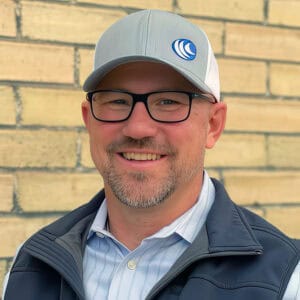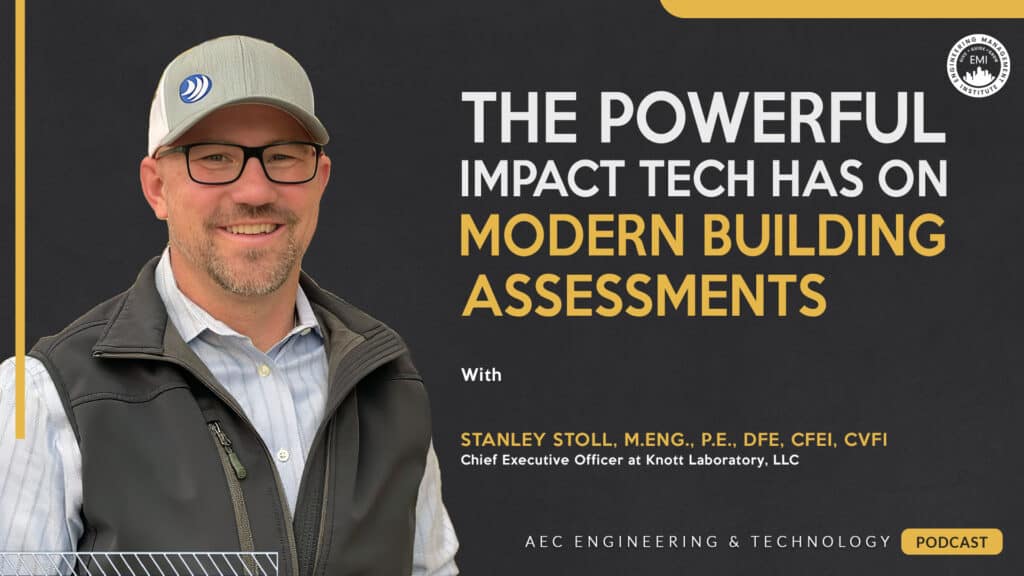In this episode, I talk with Stanley Stoll, M.Eng., P.E., DFE, CFEI, CVFI, CEO and principal engineer at Knott Laboratory, about how AI and advanced scanning tools are revolutionizing building assessments, construction defect investigations, and the future of structural engineering.
***The video version of this episode can be viewed here.***
Engineering Quotes:
Here Are Some of the Questions I Asked Stanley:
- How are new technologies and standards making building assessments safer and more effective?
- How do advanced scanning technologies provide a complete picture of a building’s condition over time?
- What is the NCSEA subcommittee doing to include new technology in standard building assessments?
- How are state agencies and updated building codes encouraging the use of new technology for building safety?
- What challenges do engineers face when adopting new technology, and how can they overcome them?
- What final piece of advice would you give to AEC professionals on using technology and standards to improve building safety?
Here Are Some Key Points Discussed in This Episode About the Powerful Impact Tech Has on Modern Building Assessments:
- New technologies such as thermal cameras, LiDAR scanners, and 3D modeling transform how engineers detect and address structural issues like water infiltration and degradation. These tools enable safer and more precise building assessments by delivering actionable insights that support effective solutions and improve structural resilience.
- Advanced scanning technologies like laser scanning provide a complete view of structural conditions by linking multiple floors and identifying misalignment or differential movements with accuracy. This approach allows engineers to conduct more thorough building assessments, saving time and reducing costs compared to traditional methods.
- The NCSEA subcommittee integrates tools like laser scanning and AI into standardized building assessments, helping engineers adopt advanced methods for precise data collection and analysis. These initiatives improve the thoroughness and efficiency of building evaluations while addressing the industry’s changing demands.
- State agencies and updated building codes introduce mandatory inspections and milestone assessments, promoting the use of technologies like thermal cameras and laser scanning. These tools ensure compliance with safety standards, lower costs for building owners, and provide reliable data for addressing structural concerns.
- Engineers face challenges such as time constraints and adapting to unfamiliar tools when incorporating new technologies. Overcoming these challenges involves adopting a growth mindset, embracing continuous learning, and making small, consistent improvements to remain effective and efficient in a rapidly evolving industry.
- AEC professionals benefit by staying curious, pursuing improvements, and using resources like podcasts, industry organizations, and conferences to explore new tools and strategies. By combining advanced technology with clear communication and a focus on client needs, they deliver impactful solutions that enhance building safety and resilience.
More Details in This Episode…
About Stanley Stoll, M.Eng., P.E., DFE, CFEI, CVFI

Mr. Stoll is a forensic structural engineer and board-certified diplomat through the National Academy of Forensic Engineers. He regularly serves as an expert witness, particularly in construction defect cases. He oversees all divisions of the company but specializes in structural engineering, including building assessment, construction defects, and foundation issues. Stan is also the co-chair of the Existing Buildings Committee with the National Council of Structural Engineers Associations (NCSEA).
About the Host: Nick Heim, P.E.

Nick’s interests lie at the intersection between the built world and technology, and he can be found looking for the ever-changing answer to the question, “How can we do this better?” Nick can be found on LinkedIn, producing content about the use of technologies in his civil engineering career and small business.
Sources/References:
Knott Laboratory
Revit
Recap
NCSEA
ASCE
ICC
Connect with Stanley Stoll, M.Eng., P.E., DFE, CFEI, CVFI, on LinkedIn
We would love to hear any questions you might have or stories you can share on the powerful impact tech has on modern building assessments.
Please leave your comments, feedback, or questions in the section below.








